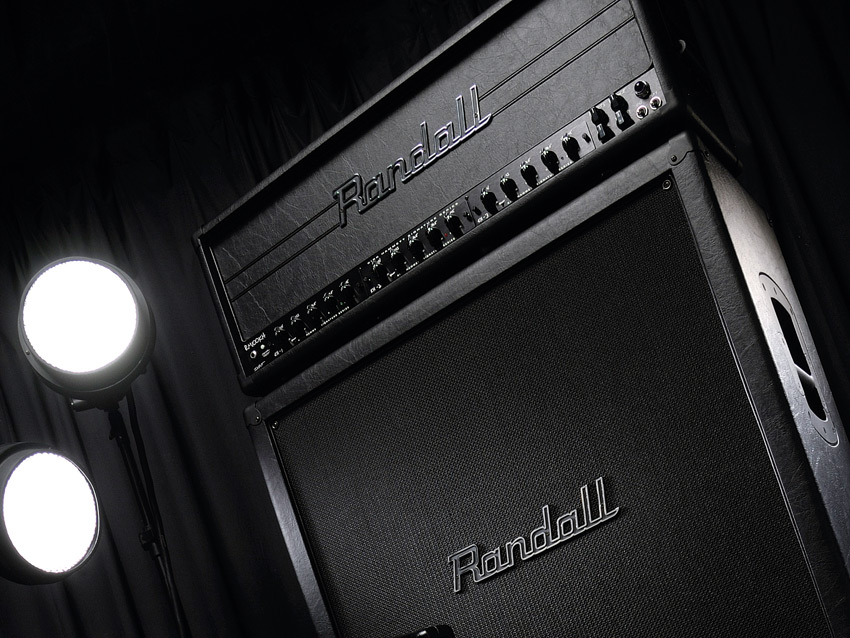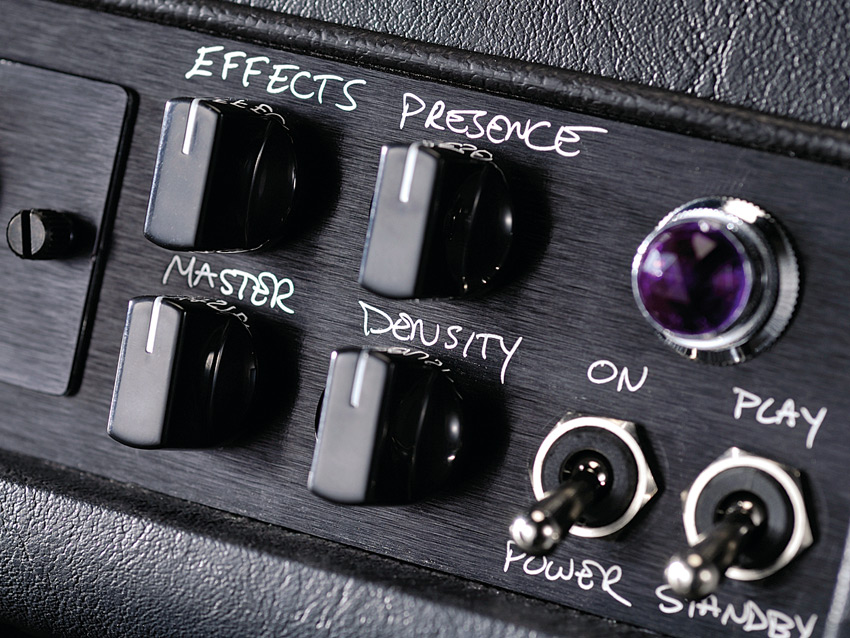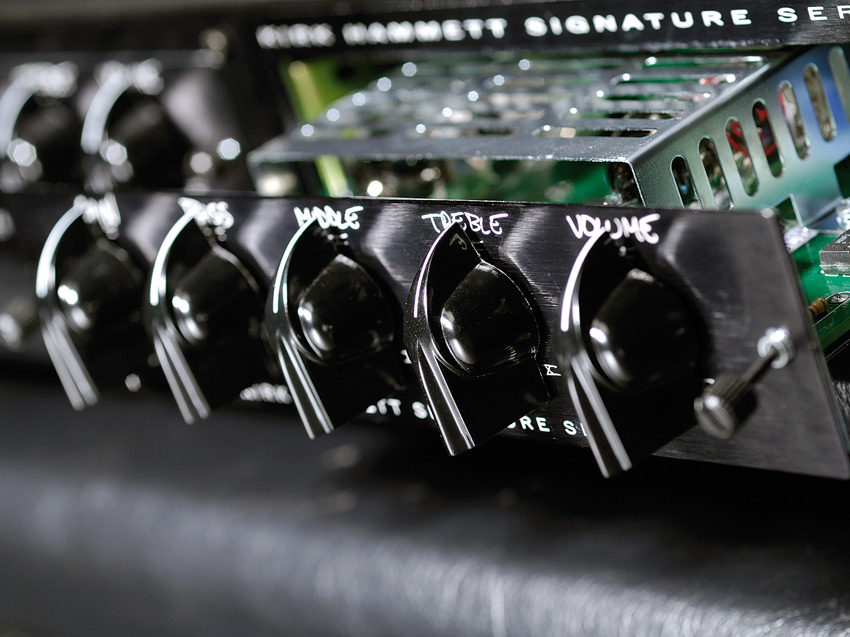MusicRadar Verdict
It's rare that head-turning clean and ultra-crunch tones are available from a single head, but that's certainly the case here. If you love Metallica, do all you (legally!) can to get hold of one.
Pros
- +
The quality of the clean module. The authenticity of the crunch tones. Modular structure.
Cons
- -
Aside from the price tag, nothing.
MusicRadar's got your back

Randall RM100KH

Randall RM100KH

Randall RM100KH
At the time of writing Death Magnetic has just hit the streets to favourable reviews and, subsequently, interest in Metallica is at a five year high. As well as the new music, we're equally enamoured to be able experience the complete range of new Kirk Hammett amps from Randall.
Randall's head honcho Doug Reynolds explains how it happened: "I've been to Metallica HQ in San Francisco and it's loaded with just about every amp you can imagine; manufacturers just send 'em everything. We got lucky that [Anthrax guitarist] Scott Ian is a user and he's a close friend of Kirk. He said he was interested in exploring some new tones, so Scott offered to hook him up with us.
"David Karon, our A&R guy, was the first to talk to Kirk and I started modifying a bunch of our modules based on what we thought Kirk was looking for. We sent those for him to check out; they were fairly similar, just with a different voicing.
"The crunch from KH2 is the rhythm sound most Metallica fans will be familiar with."
"Pretty much on the first try he loved one of them, so we started going back and forth at that point and it only took a couple of times to nail in the main tone, which is the KH2 [module]. We were probably in talks over a period of 10 to 12 months."
RM100KH
This is the main US-made head that Kirk is using around Randall's innovative Modular design. As with all current modular heads in the catalogue, the RM100KH includes three specifically voiced preamp modules.
"We started with the KH2 and got talking about what other modules he wanted," explains Reynolds. "For his clean sound he'd been using a bunch of Fenders over the years, so we started tweaking [one of] our Fender-style modules into more of a pseudo Blackface/Bassman combination. We went back and forth a couple of times on the clarity of the high-end before we got it right, but it's more Blackface than Tweed."
Randall also produces a number of signature and standard modules that each include a pair of 12AX7 tubes and are safely interchangeable by even the most ham-fisted individual. Merely unscrew a module from the chassis by hand and remove it, whereby you can slot - carefully - a new one into the gap. It really is as easy as pie.
Want all the hottest music and gear news, reviews, deals, features and more, direct to your inbox? Sign up here.
"Add the merest touch of reverb, and you have a clean tone that many players, regardless of musical genre, would be proud of."
"It is possible to switch various modules in and out, of course; they're all interchangeable," Reynolds assures us. "You can use the Hammett modules with the standard combos and heads too."
The burning question, then: why buy a Hammett head at all, when a standard RM100H is a cheaper option? The answer is that if you want the exact Hammett tone, you will need the RM100KH as its power section is slightly different.
"When I actually got with him face-to-face and took a day to dial in all the modules to get the amp where he wanted it with the cabinets he was using, I did end up beefing up the power section just a little bit," confirms Reynolds. "It was just one capacitor changed to let more sub low-end through."
The power section includes a quartet of Slovakian JJ 6L6GC valves plus a trio of ECC83S bottles that, in order, represent the first gain stage of the preamp section, a valve buffer for both effects loops, and a phase inverter.
Also included is a three-way Randall footswitch to select the modules, and we reckon the provision of chicken-head knobs and lettering - in Kirk's own hand, no less - adds a great deal to the whole vibe.
Sounds
See Guitarist's Simon Bradley give the RM100KH a workout in the video below:
Before we plugged in, we asked Doug to address the issue of Kirk's use of active EMG pickups with his glut of ESP guitars. Will using passive coils affect the authenticity of the tone at all?
"That doesn't really matter with the high-gain modules but, with the clean module, absolutely. Obviously the active pickups hit the front end a lot harder so we had to pad down the front end a little bit so it'd stay nice and clean at higher volumes."
For the majority of the sound testing we used an EMG-equipped ESP KH-3, with our trusty Seymour Duncan-loaded ESP GL-56 on standby. As a starting point we set all module pots to noon, which was especially helpful in illustrating that the tone from the KH2 is slightly darker - almost more 'squashy' - in nature than that of KH3.
Once you dial more suitable settings, the crunch from KH2 is indeed the rhythm sound most Metallica fans will be familiar with. There's a ton of musical low-end push, as you'd expect, and even with the middle pot set to half, the tone is perfectly suited to muted chords and staccato notes.
KH3 would be perfect for solo work as it's certainly hotter to our ears and, subsequently, offers more cut if required, but there would be nothing stopping you from reversing the utilisation of the two: using the KH2 with the neck EMG causes walls to shake!
Proceedings can become slightly mushy due to the sheer level of gain compression but, by balancing the master presence and density controls (the latter allows you to regulate the low-mid 'feel' of the overdrive), any loss of clarity can be quickly counteracted to give a most triumphant roar. Each module also has a bright switch for an additional and subtle treble hike when required.
"You're not required to be a Hammett fan to own and use an example, but there's probably little point in undertaking the financial outlay if you're not."
In contrast the clean KH1 module certainly does have plenty of Fender-y character, with that unmistakable attack at the beginning of the note adding to a tone full of chime and shimmer. Add the merest touch of reverb, and you have a clean tone that many players, regardless of musical genre, would be proud of.
"It's great for us," Doug Reynolds enthuses. "There's never been a signature amp associated with Metallica and for the first to be us, it was just a great feather in our cap. It was a lot of luck and the right combination of contacts, but Kirk was really intrigued by the modular concept and appreciates what we're doing."
He's justifiably proud as the RM100KH is a high-class and very toneful amp. As ever, you're not required to be a Hammett fan to own and use an example, but there's probably little point in undertaking the financial outlay if you're not.
You could truly use the RM100KH, with the added versatility afforded by the myriad models available, for virtually all applications: an amp worthy of the man and his band.
Simon Bradley is a guitar and especially rock guitar expert who worked for Guitarist magazine and has in the past contributed to world-leading music and guitar titles like MusicRadar (obviously), Guitarist, Guitar World and Louder. What he doesn't know about Brian May's playing and, especially, the Red Special, isn't worth knowing.